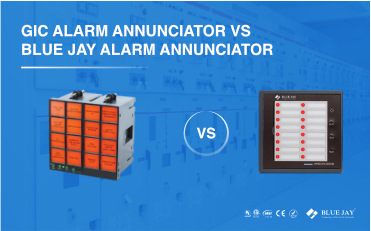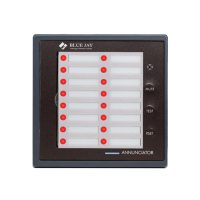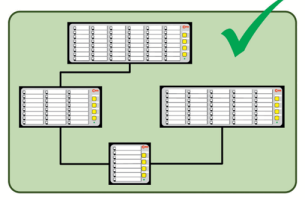
GIC Alarm Annunciator VS Blue Jay Alarm Annunciator
In modern industry and automation, alarm annunciators are essential

Both the EES Annunciator and Blue Jay Fault Annunciator are key devices that present system faults, status changes, or alarm information to operators through sound and light. To help you choose the right alarm annunciator, this article will introduce the similarities and differences between them.


Core Function: Both devices are primarily designed to serve as fault annunciators. Their main purpose is to monitor electrical or industrial systems and provide immediate signaling when a fault or alarm condition occurs.
Alarm Mechanisms: Both utilize a combination of visual and audible alarms to alert operators. They use LEDs on the front panel to provide a visual indication of the fault status and offer a way to connect an audible alarm (such as a buzzer or horn) to attract attention.
Signal Inputs: Both annunciators accept digital input signals (typically dry contact closure) from external sources. These sources can include protective relays, circuit breakers, sensors, or other control devices. Both EES Annunciator and Blue Jay Fault Annunciator are multichannel Annunciators.
Industrial Application: Both products are intended for use in industrial or commercial environments. They are designed for panel mounting and are built to be robust enough for use in control cabinets and electrical panels. They are commonly used in sub-stations, transformer stations, pump stations, industrial facility monitoring, and a variety of panels, including process plants, Diesel Generators, Control Rooms, C & R panels, Material handling Systems, Instrumentation Panel, Battery Charger panel, and Compressor control panel.
Goal of Use: The ultimate goal of both annunciators is the same: to enhance operational safety, improve maintenance efficiency, and reduce system downtime by providing a clear and immediate indication of where and when a fault has occurred.
Protection Class of panel: EES Annunciator and Blue Jay Fault Annunciator’s front panel meet IP 54.
Labeling: Both annunciators use directly insertable designation strips for labeling. The EES Annunciator’s labels are inserted vertically, while the Blue Jay Annunciator’s labels are inserted horizontally.
A cascaded fault annunicator system: The EES Annunciator uses a cascading function to connect up to four devices via the CAN bus interface to form an alarm system. One device acts as the master, and the others act as slaves. When creating an alarm system, the master device must have at least the same number of channels as the slaves. Blue Jay can also create similar alarm systems, with no specific requirements for the number of channels between the master and slave devices.


Types: EES offers a tiered product line with three types of fault annunciators: a basic model, a software-configurable model, and a model with protocol interfaces. In contrast, Blue Jay provides a single, general-purpose annunciator.
Multiple signal inputs & sizes: While both companies offer multi-channel annunciators, their product lines differ significantly in size and input capacity.
EES provides six different input options (8, 16, 24, 32, 40, or 48 signals) that correspond to three different physical sizes: The 96x96mm size is available for 8 or 16 inputs. The 96x192mm size is suitable for 16, 24, or 32 inputs. The 96x287mm size is used for 40 or 48 inputs.
In contrast, the Blue Jay fault annunciator comes in a single 96x96mm size, which accommodates a range of input options from 4, 6, 8, 10, 12, or up to 16 signals.
Configuration of the annunciator: The EES annunciator offers multiple configuration options, including front panel buttons, DIP switches, or PC software. In contrast, the Blue Jay annunciator is configured exclusively through the front panel buttons, which makes it a more straightforward process.
Alarm relay output: The Blue Jay annunciator is equipped with a single alarm relay, while EES annunciators are equipped with multiple repeat relays, allowing for a dedicated relay for each signal input.
Operation indication: The EES fault annunciator uses a dual-color system where a green LED indicates a normal state and a red LED signals a fault. In contrast, the Blue Jay annunciator only uses a red LED to indicate a fault, with the absence of a light signifying a normal state.
The EES Annunciator is a professional tool that provides robust, scalable solutions to complex problems. The Blue Jay Annunciator is a practical tool that provides efficient and cost-effective solutions to common needs. The choice should be based on the size and complexity of your project, your budget, and your need for brand reliability.

In modern industry and automation, alarm annunciators are essential





